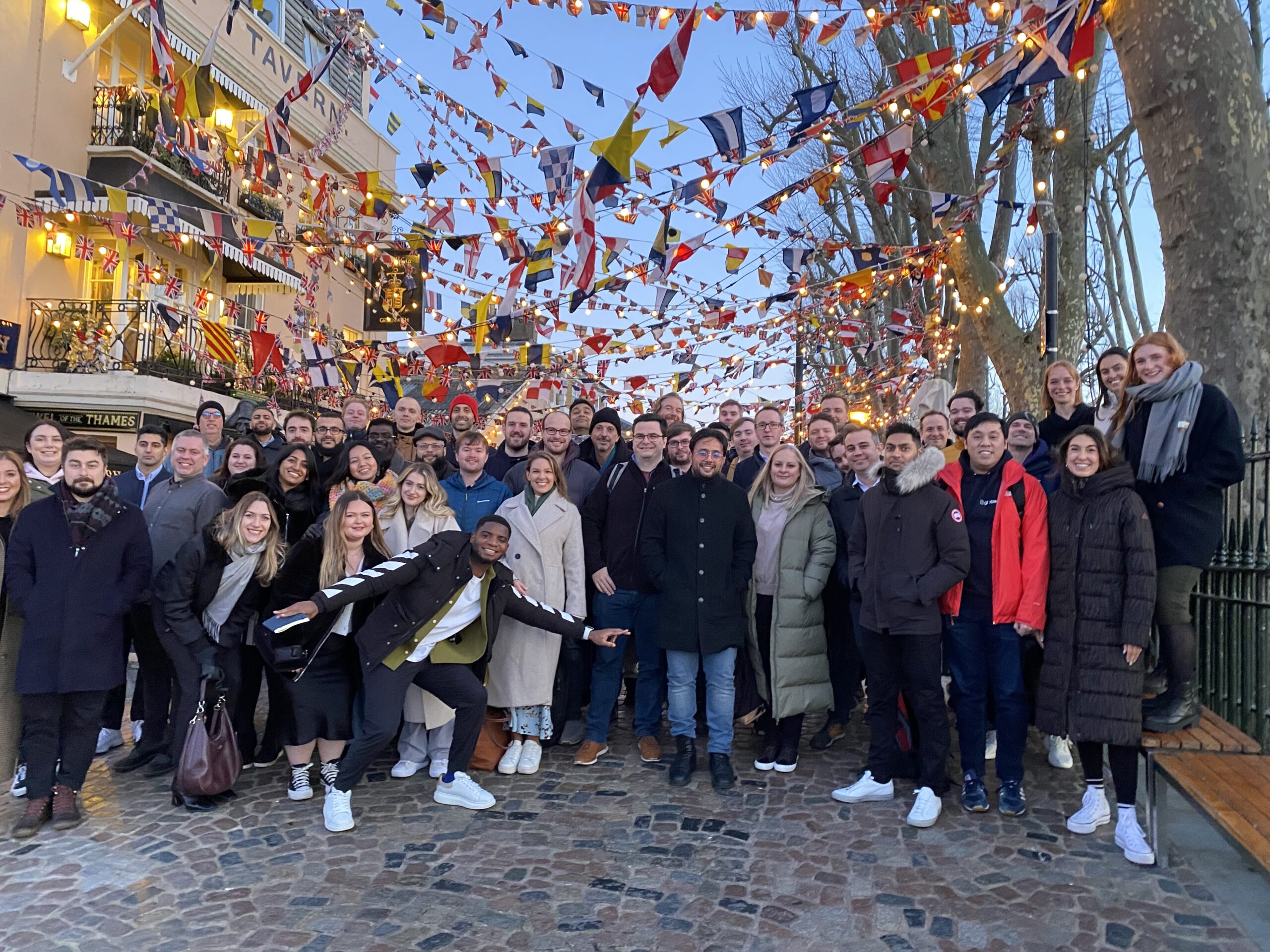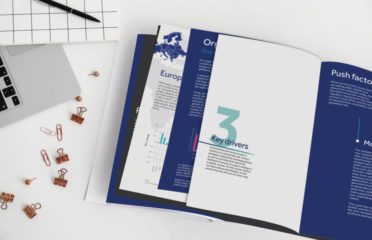Inspiring inclusion at every level

“As an organisation we are focused on success. That success can only result from every person in the organisation driving forward as one collective unit, with every person taking ownership. That means empowerment at every level and irrespective of gender, ethnicity or any other visual genetic differentiator.”
Creating an environment where everyone feels not only safe to vocalise their thoughts, but actually feels empowered to do so is paramount to success.”
Myles Milston, CEO
To mark International Women’s Day 2024, we connected with colleagues from across our business to hear their thoughts on what inclusion means to them, why it matters and how as both an industry and organisation we can be more inclusive.
Thanks to our contributors Megan Hoskin (Operations Manager), Kristina Kawas (Head of Account Management), Namrata Pun (Product Designer) and Aiman Syed (1st Line Support Assistant).
How can organisations best promote inclusivity for women, particularly in Finance and Technology?
Megan: Promoting and representing successful, inspiring women as role models and in leadership roles. This paves the way to more inclusive workplaces and organisations, and the strength of female representation in senior positions was a significant one of many factors that drew me to Globacap.
Also, fostering a culture that promotes work/life balance, and in which an individual’s personal commitments outside of the workplace have no bearing on their perceived ability to perform within it, remains a key way to champion inclusivity in my eyes.
Kristina: Firms should aim to remove bias in hiring. Society has ingrained in our minds that women are right for certain types of roles, while men are right for others. Try to be open-minded when hiring, not dismissing anyone based on factors such as age, gender. Not only may they be the best candidate for the role, but they may also bring an interesting and diverse perspective to the team.
Firms should also provide training on unconscious bias, to help people identify thoughts or patterns that have been ingrained in them by society and how they can remove them.
Finally, promote open discussions around inclusivity. Reading and discussing a book like Invisible Women or Unconscious Bias can be a good starting point to help people think beyond their typical preconceptions.
Aiman: To foster inclusivity for women in finance and technology, organisations should introduce measures such as mentorship programs, unconscious bias training, and flexible work options. Creating a culture that appreciates diverse viewpoints and actively tackles gender-related challenges is essential for establishing an environment where women can thrive and feel empowered in these sectors.
Namrata: I think this starts with educating employees and learning what it means to be an inclusive organisation. We have all lived different experiences so we might have internalised different conditionings. So, I believe that it’s important to pay attention to our own biases and examine the assumption that we hold about women or other groups.
It’s also important that different committees in workplaces are represented by diverse members. Companies can establish programs to mentor and sponsor women so that there are opportunities for skill growth, networking, and advancement into leadership positions.
As with everything, creating spaces and a platform which allows everyone a chance to voice their experiences would be great.
This year’s International Women’s Day theme is #InspiringInclusion, what does this mean/look like for you?
Megan: To me, inspiring inclusion means that organisations are inspired by the unique and immense value of female representation at all levels and across all roles within an organisation, and are motivated to foster a culture and environment of inclusivity to both promote, and ensure it. It also means inspiring women to want to be a part of such organisations, and to feel represented, included, and empowered within them.
Namrata: For me, #InspringInclusion encapsulates the idea of actively promoting and celebrating diversity in all its forms where everyone feels valued and empowered to be who they are and can contribute their unique perspectives. It also means amplifying the voices of those who are excluded and providing platforms for them to share their stories, achievements, and challenges.
What challenges have you faced, as a woman, entering this industry?
Megan: During my career in technology and operations, there are times that I have been perceived as non-technical support whilst male counterparts have been regarded as technologists in their own right. I’m fortunate to have been able to be selective about the organisations I work with as my experience has grown, and to work in environments with individuals and leaders who appreciate the technical expertise that my work requires, irrespective of the gender of the individual undertaking it. But I’m aware of too many environments today where this is still not the case.
Namrata: Being a Nepali woman, it was quite difficult at first in this industry as there was a lack of representation for people like me. I would always try and find people who had “made it” and looked like me and had lived similar experiences. However, the underrepresentation of women in leadership positions in this industry sometimes led me to feel isolated and suffer imposter syndrome.
Aiman: Sometimes gender disparity is so subtle in the surroundings that you don’t even recognise that you are being part of it.
Luckily, I belong to a family whose core values are to believe in gender parity and equal opportunities. Despite living in a small town in Sindh (Khairpur Mirs), it took me almost 6 months to enter the Pakistani software industry based in the metropolitan city Karachi (Sindh). This includes 2-3 times where I had to travel 450 kilometers for interview sessions in just a month. All this effort landed me my first job in technology back in 2016. The challenge was huge – I had to prove my worth and skills being a fresh female graduate who was also considered an outsider.
What were some key experiences that supported your professional development?
Aiman: Upskilling, certifications, participation in different conferences, and writing technical blogs can always boost your confidence and information stack, room for always improving and learning can keep you running, and motivating all these efforts helps in deriving not only professional but personal development and goals collectively.
Namrata: Firstly, giving myself permission to not know rather than pretend to know is something that has really helped me and put me at ease.
Additionally, supportive mentors and colleagues who guide you to become better truly build you up. I also appreciate colleagues who are compassionate, listen to you and stand up for you when they see or feel that you need that support. A team that celebrates and shares each other’s wins is always wonderful!
Also, being in communities, for example UX communities, is helpful to me as I get to understand other people’s experiences in the industry, and learn about how they’ve tackled those challenges.
Do you have a woman who inspires you most and why?
Megan: Whilst far removed from the Tech sector, Tracy Edwards, the first woman to skipper a crew, let alone an all-female crew, in the 1989 Whitbread Round the World Yacht race at a time when women were often perceived both within the sailing community and wider society as having no place in such endeavours, has long been an inspiration. She reportedly once asked her mum “How do I change the world?”, to which her mum replied “You can’t change the world, yet. But you can change your world now”. I’ve always believed that even when we can’t see a singular action or direct path to global change, there is immense power in the collective actions of many, be they on the smallest or greatest of scales.
Kristina: Not a woman, but a group of women inspire me – working mothers! I don’t have children, but I have seen from friends and colleagues just how difficult the balancing act can be when they are essentially working two full-time jobs (one at the office and one at home). While we have seen men taking on additional responsibilities at home over the years, there are still some things that only a mother can help with (biologically or otherwise), that may lead to them taking on more of the burden.
Aiman: Hands-on, my mom. She is the epitome of grace, courage, patience, and an amazing home maker.
Namrata: To me, Malala Yousafzai is one of the women who inspires me every day. Her resilience, courage and commitment to promoting education for girls around the world, her advocacy for women’s rights and her bravery to speak out continuously despite the challenges around her is respectable.
How do you think we can encourage employment of women in Tech?
Megan: By promoting education and understanding of tech to young women and girls, its application to the world, and the creative, trail blazing and change making opportunities within it. Research suggests that these are areas really that matter when forming notions and making path-leading decisions about future careers at an early stage. We need organisations to really champion this, and to support women in realising these opportunities by continually striving to achieve and maintain inclusive, inspiring cultures and workplaces.
Aiman: Encouraging the employment of women in the tech industry requires a comprehensive approach that addresses both recruitment and retention challenges. Firstly, organizations can implement targeted outreach initiatives, collaborating with schools, colleges, and community organizations to introduce young women to STEM fields early in their education. Providing scholarships, internships, and mentorship opportunities can further incentivize women to pursue careers in technology.
In the recruitment process, companies should adopt diverse and unbiased hiring practices. This involves actively seeking out qualified women candidates, using gender-neutral language in job descriptions, and ensuring diverse interview panels to mitigate unconscious biases. Transparent reporting on gender diversity metrics can also hold organizations accountable and showcase their commitment to inclusivity.
To foster a supportive workplace culture, companies should establish mentorship and sponsorship programs that connect women with experienced professionals in the industry. Creating affinity groups or ‘women in tech’ networks can provide a sense of community and facilitate knowledge-sharing and career development.
Furthermore, organizations need to address systemic issues affecting work-life balance by offering flexible work arrangements, parental leave policies, and opportunities for career advancement that accommodate various life stages. Promoting diversity at leadership levels is crucial, as visible representation encourages aspiring women technologists and signals the organization’s commitment to gender equality.
In summary, encouraging the employment of women in tech necessitates a multifaceted strategy encompassing educational outreach, inclusive recruitment practices, supportive workplace policies, and targeted professional development opportunities. By addressing these aspects collectively, organizations can build a more diverse and inclusive tech workforce.
Namrata: Some ways I think we can encourage employment of women in the tech industry are:
- To address gender bias – Implement bias-free hiring practices, provide diversity and inclusion training for employees and create work spaces where everyone feels seen, heard and respected.
- To encourage girls to study STEM at an early age, and
- To create spaces for women to network and build communities – this can allow women to be inspired, connect with professionals and at the same time enhance skills.
What role do you think our leadership play in forging gender parity?
Megan: Leadership play a vital role in forging gender parity in many ways; by ensuring the representation and visibility of women across all roles and levels of the organisation; by championing women as roles models both internally and in the wider industry; by striving to create and nurture a culture that values the skills that women and men both uniquely and collectively bring to an organisation, understanding and appreciating differing needs and experiences and supporting inclusivity across these; by ensuring that women and men have equal opportunity for development and progression in their careers whilst neither are disadvantaged; and by focused efforts to ensure that we continue to attract and be attractive to female talent, at all stages of their careers, as an inspiring, inclusive and equal team to be a part of.
Aiman: Leadership plays a pivotal role in forging gender parity by setting the tone for organizational culture and policies. Firstly, leaders must actively advocate for gender equality, both within the workplace and in external engagements. By visibly supporting initiatives that promote diversity and inclusivity, leaders signal a commitment to creating an environment where gender parity is not only acknowledged but actively pursued.
Leaders also play a crucial role in shaping organisational policies that address gender-related challenges. This includes implementing transparent and unbiased hiring and promotion processes, as well as establishing family-friendly policies such as parental leave and flexible work arrangements. By fostering an inclusive work environment, leaders can attract and retain diverse talent, contributing to the overall success and innovation of the organisation.
Moreover, leadership should prioritize mentorship and sponsorship programs specifically aimed at supporting women’s professional development. Creating pathways for women to advance in their careers and providing equal opportunities for skill development are essential components of leadership’s role in achieving gender parity.
Furthermore, leaders can use their influence on challenge and reshape industry norms and practices that perpetuate gender disparities. Engaging in industry-wide conversations, advocating for policy changes, and actively participating in initiatives that promote gender equality contribute to broader societal change.
In summary, leadership’s role in forging gender parity extends beyond rhetoric to encompass policy implementation, cultural influence, and advocacy for systemic change. By taking proactive steps and fostering an inclusive environment, leaders can drive meaningful progress toward achieving gender equality within their organisations and, by extension, in society at large.
What is your view on the awareness of roles in engineering and technology for young women? How can we do more/better?
Aiman: The awareness of roles in engineering and technology for young women has improved in recent years, but there is still work to be done to dispel stereotypes and highlight diverse career paths. To do more and better, it is essential to implement targeted outreach programs, highlight successful female professionals in these fields, and collaborate with educational institutions to provide mentorship and hands-on experiences that inspire young women to pursue careers in engineering and technology.
Along with such efforts, storytelling can be the best medium to reach and inspire young women. Highlighting efforts and challenges and the solutions to overcome those challenges and prepare young women to enter in engineering and technology.






















